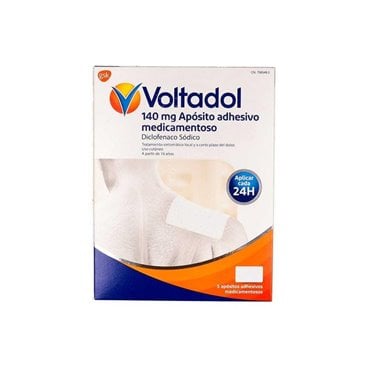Voltadol 140 Mg 5 Medicated Adhesive Dressings
Voltadol 140 Mg 5 Medicated Adhesive Dressings is a medication that relieves pain. It belongs to a group of medicines called non-steroidal anti-inflammatory drugs (NSAIDs). This medicine is used for the short-term (maximum 7 days) local symptomatic treatment of pain associated with acute strains, sprains or bruises in the arms and legs as a result of blunt injuries in adolescents aged 16 years and over and in adults.
Voltadol 140 Mg 5 Medicated Adhesive Dressings is a medication that relieves pain. It belongs to a group of medicines called non-steroidal anti-inflammatory drugs (NSAIDs). This medicine is used for the short-term (maximum 7 days) local symptomatic treatment of pain associated with acute strains, sprains or bruises in the arms and legs as a result of blunt injuries in adolescents aged 16 years and over and in adults.
Voltadol (140 Mg 5 Medicated Adhesive Dressings)
PHARMACOKINETICS
* Dressings: diclofenac is slowly absorbed through the skin. A continuous and sustained release is produced, obtaining Cp of 3 ng/ml. The binding affinity of diclofenac to plasma proteins is high (99%). Metabolism and elimination are similar after dermal and oral use.
INDICATIONS
- Symptomatic treatment of processes that occur with [INFLAMATION] and/or [ACUTE PAIN], such as:
* [CONTUSION] or [SPRAIN] produced by sprains.
POSOLOGY
"Voltadol dressings"
A medicated adhesive bandage should be applied to the painful area once a day. The maximum daily dose is 1 medicated plaster per day, even if there is more than one injured area to treat. Therefore, only one painful area can be treated at a time.
PRECAUTIONS
- [PHOTOSENSITIVITY REACTIONS]. Diclofenac has given rise to photosensitivity reactions. It is recommended not to expose the treated areas to the sun or UV light for at least one day.
- Systemic reactions. The risk of systemic reactions to topical diclofenac is minimal, although it cannot be ruled out if there is significant systemic absorption, as can happen if it is applied to damaged skin areas (dermatitis, burns, wounds) or with an occlusive dressing. It is recommended to adhere to the dosage recommendations in patients with asthma, history of peptic ulcer, renal or cardiac insufficiency, as well as hypertension.
ADVICE TO THE PATIENT
- Do not cut dressings into pieces.
- Do not use for more than 7 days.
PREGNANCY
Animal Safety: Prenatal, perinatal and postnatal development of the progeny was not affected.
Safety in humans: Approximately 10% of the topical dose is absorbed systemically with considerably lower bioavailability from the topical route than from the oral route. Adequate and well-controlled studies in humans with topical diclofenac are not available, but systemic diclofenac has resulted in fetal toxic effects in late pregnancy. Although skin absorption is minimal, it cannot be ruled out that systemic effects do not appear.
The topical use of diclofenac during the first two trimesters of pregnancy is only accepted if, in the absence of other safer therapeutic alternatives, the benefits outweigh the possible risks.
The use of diclofenac during the third trimester of pregnancy is contraindicated, since diclofenac has been associated with delayed delivery and adverse cardiopulmonary effects in the fetus, such as premature closure of the ductus arteriosus and pulmonary hypertension, and renal adverse effects, such as acute renal failure and oligohydramnios. It can also increase the bleeding time in the mother.
Effects on Fertility: There is no evidence that diclofenac has a teratogenic potential in mice, rats, or rabbits. In humans, preclinical data from acute and repeat dose toxicity studies, as well as genotoxicity, mutagenicity, and carcinogenicity studies with diclofenac have revealed no specific risk at the anticipated therapeutic doses.
LACTATION
Safety in animals: no data available.
Safety in humans: Diclofenac is excreted in milk, although it is believed to have no adverse effects on the nursing infant. Due to insufficient data, a decision has to be made whether to discontinue breastfeeding or to interrupt/suspend treatment after considering the benefit of breastfeeding for the child and the benefit of treatment for the mother.
ADVERSE REACTIONS
- Dermatological: Frequent (1-10%) local reactions in the area of application, such as [PRURITUS], [SKIN IRRITATION], [ERITEMA], [SKIN ERUPTIONS], with the appearance of pustules or papules on occasions.
- Allergic: Uncommon (0.1-1.0%) [HYPERSENSITIVITY REACTIONS], [CONTACT DERMATITIS]; specific cases of [ANAPHYLAXIA], [ANGIOEDEMA] and [PHOTOSENSITIVITY REACTIONS].
In case of significant absorption, systemic adverse reactions of diclofenac could appear.
OVERDOSE
Symptoms: Due to its route of administration, symptoms are not very likely to appear in case of overdose, although accidental ingestion or improper application could produce the typical systemic adverse effects.
Treatment: In case of accidental ingestion, stomach lavage and symptomatic treatment will be carried out.



